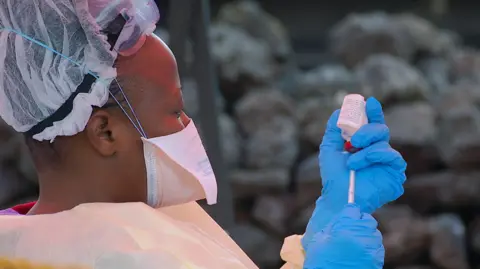As cases of chikungunya soar in China's Guangdong province, health officials are taking drastic action reminiscent of Covid-19 responses. Since July, more than 7,000 instances of the mosquito-borne virus have been documented, particularly in Foshan city, where patients are required to stay hospitalized under protective mosquito nets until they test negative or complete a week-long stay.
Chikungunya, transmitted through infected mosquito bites, causes fever and debilitating joint pain that can persist for years. Despite being predominantly found in South and Southeast Asia and parts of Africa, Guangdong has seen a surge of nearly 3,000 new cases in just the last week. Moreover, Hong Kong confirmed its first case, affecting a traveling 12-year-old boy.
The virus isn’t contagious from person to person but spreads when a mosquito bites an infected individual. Currently, all reported cases in China have been mild, with 95% of patients discharged within seven days. Yet the unfamiliarity of the virus has stirred anxiety among citizens, as reflected in comments on Weibo.
In a bid to contain the spread, Guangdong authorities are intensifying measures, including removing standing water to eliminate mosquito breeding grounds. Penalties of up to 10,000 yuan ($1,400) have been imposed for non-compliance. Additionally, giant mosquito-eating fish are being released into local bodies of water, and drones are employed to locate stagnant water sources. Initially, travel restrictions required a 14-day home quarantine for travelers from Foshan; however, those have since been lifted.
Chikungunya, first identified in Tanzania in 1952, has been reported in over 110 countries. Common symptoms appear within three to seven days after being bitten, including fever, rash, and muscle pain, with most patients recovering in about a week. However, those with pre-existing conditions could face more severe symptoms.
The World Health Organization emphasizes reducing stagnant water to stop the virus's spread, a recommendation authorities are actively promoting across Guangdong.
Chikungunya, transmitted through infected mosquito bites, causes fever and debilitating joint pain that can persist for years. Despite being predominantly found in South and Southeast Asia and parts of Africa, Guangdong has seen a surge of nearly 3,000 new cases in just the last week. Moreover, Hong Kong confirmed its first case, affecting a traveling 12-year-old boy.
The virus isn’t contagious from person to person but spreads when a mosquito bites an infected individual. Currently, all reported cases in China have been mild, with 95% of patients discharged within seven days. Yet the unfamiliarity of the virus has stirred anxiety among citizens, as reflected in comments on Weibo.
In a bid to contain the spread, Guangdong authorities are intensifying measures, including removing standing water to eliminate mosquito breeding grounds. Penalties of up to 10,000 yuan ($1,400) have been imposed for non-compliance. Additionally, giant mosquito-eating fish are being released into local bodies of water, and drones are employed to locate stagnant water sources. Initially, travel restrictions required a 14-day home quarantine for travelers from Foshan; however, those have since been lifted.
Chikungunya, first identified in Tanzania in 1952, has been reported in over 110 countries. Common symptoms appear within three to seven days after being bitten, including fever, rash, and muscle pain, with most patients recovering in about a week. However, those with pre-existing conditions could face more severe symptoms.
The World Health Organization emphasizes reducing stagnant water to stop the virus's spread, a recommendation authorities are actively promoting across Guangdong.






















